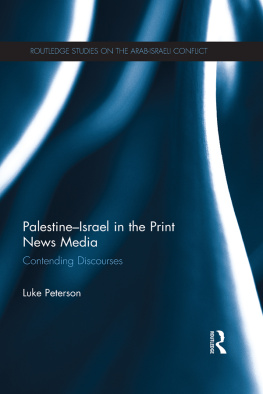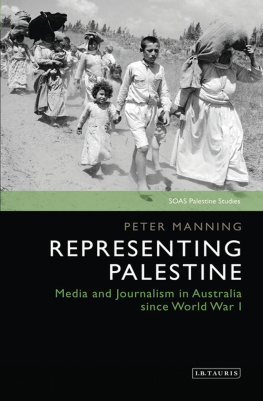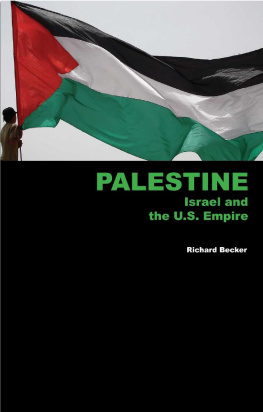PalestineIsrael in the Print News Media: Contending Discourses
PalestineIsrael in the Print News Media: Contending Discourses is concerned with conceptions of language, knowledge, and thought about political conflict in the Middle East in two national news media communities: the United States and the United Kingdom.
Arguing for the existence of national perspectives which are constructed, distributed, and reinforced in the print news media, this study provides a detailed linguistic analysis of print news media coverage of four recent events in the PalestinianIsraeli conflict in order to examine ideological patterns present in print news media coverage. The two news communities are compared for lexical choices in news stories about the conflict, attribution of agency in the discussion of conflict events, the inclusion or exclusion of historical context in explanations of the conflict, and reliance upon essentialist elements during and within print representations of PalestineIsrael. The book also devotes space to first-hand testimony from journalists with extensive experience covering the conflict from within both news media institutions.
Unifying various avenues of academic enquiry reflecting upon the acquisition of information and the development of knowledge, this book will be of interest to those seeking a new approach to the PalestinianIsraeli conflict.
Luke Peterson completed his doctoral studies at Kings College, Cambridge investigating language, news media, and discourse surrounding the PalestinianIsraeli conflict. His current research includes analysis of the conflict within the context of global, economic neoliberalism.
ROUTLEDGE STUDIES ON THE ARABISRAELI CONFLICT
Series Editor: Mick Dumper, University of Exeter
The ArabIsraeli conflict continues to be the centre of academic and popular attention. This series brings together the best of the cutting edge work now being undertaken by predominantly new and young scholars. Although largely falling within the field of political science the series also includes interdisciplinary and multidisciplinary contributions.
1. International Assistance to the Palestinians after Oslo
Political Guilt, Wasted Money
Anne Le More
2. Palestinian Political Prisoners
Identity and Community
Esmail Nashif
3. Understanding the Middle East Peace Process
Israeli Academia and the Struggle for Identity
Asima A. Ghazi-Bouillon
4. Palestinian Civil Society
Foreign Donors and the Power to Promote and Exclude
Benot Challand
5. The JewishArab City
Spatio-Politics in a Mixed Community
Haim Yacobi
6. Zionist Israel and Apartheid South Africa
Civil Society and Peace Building in Ethnic-National States
Amneh Daoud Badran
7. The Political Right in Israel
Different Faces of Jewish Populism
Dani Filc
8. Reparations to Palestinian Refugees
A Comparative Perspective
Shahira Samy
9. Palestinian Refugees
Identity, Space and Place in the Levant
Edited by Are Knudsen and Sari Hanafi
10. The Rise and Fall of Arab Jerusalem
Palestinian Politics and the City since 1967
Hillel Cohen
11. Trans-Colonial Urban Space in Palestine
Politics and Development
Maha Samman
12. Zionism and Land Tenure in Mandate Palestine
Aida Asim Essaid
13. Women, Reconciliation and the IsraeliPalestinian Conflict
The Road Not Yet Taken
Giulia Daniele
14. UNRWA and Palestinian Refugees
From Relief and Works to Human Development
Edited by Sari Hanafi, Leila Hilal and Lex Takkenberg
15. The Naqab Bedouin and Colonialism
New Perspectives
Mansour Nsasra, Richard Ratcliffe, Sarab Abu Rabia-Queder and Sophie Richter-Devroe
16. PalestineIsrael in the Print News Media
Contending Discourses
Luke Peterson
PalestineIsrael in the Print News Media:
Contending Discourses
Luke Peterson
First published 2015
by Routledge
2 Park Square, Milton Park, Abingdon, Oxon OX14 4RN
and by Routledge
711 Third Avenue, New York, NY 10017
Routledge is an imprint of the Taylor & Francis Group, an informa business
2015 Luke Peterson
The right of Luke Peterson to be identified as author of this work has been asserted by him in accordance with sections 77 and 78 of the Copyright, Designs and Patents Act 1988.
All rights reserved. No part of this book may be reprinted or reproduced or utilised in any form or by any electronic, mechanical, or other means, now known or hereafter invented, including photocopying and recording, or in any information storage or retrieval system, without permission in writing from the publishers.
Trademark notice: Product or corporate names may be trademarks or registered trademarks, and are used only for identification and explanation without intent to infringe.
British Library Cataloguing in Publication Data
A catalogue record for this book is available from the British Library
Library of Congress Cataloging in Publication Data
A catalog record for this book has been requested
ISBN: 978-1-138-78164-1 (hbk)
ISBN: 978-1-315-76975-2 (ebk)
Typeset in Times New Roman
by Saxon Graphics Ltd, Derby
Contents
Like all books many years in the making, this work owes a great deal to a great many people, without whom it would have been in every way impossible for me to envision or engage, let alone complete. To Drs Bert Vaux and Lori Allen I am indebted to you both for your patience, for your thoughtful approach to my work, for your helpful critique, and for your continuing support of my academic career. To James Logan (Clare College) and Oceane Li-Le-Dantec (Homerton College) I owe a tremendous debt of gratitude for your voluntary assistance with my research. To Andre Hough, Matthew Merrick, Mansour Ahmed, and Morgan Condon, for chats and jokes, for laughter and support, and above all, for true friendship, I am truly grateful and I am forever in your debt.
To my father who taught me the value of hard work and the importance of achievement in all things, thank you. To my mother who turned my gaze outward and taught me to see all the world and all of its people as special, as vital, and as a resource to be valued and protected, thank you. To my brother and my best friend, for being my mentor, for being my guide, for being the model of a man I have long emulated, thank you. To my wife and partner, words fail to express all that you have done for me, and all that is owed yet almost surely can never be repaid. For you in my life I could not be more thankful.
And to my young son, you dont know it yet but you have already saved your father a hundred times over. You give me purpose and direction. You give me insight and wisdom. You give me patience and perspective. But most of all, my son, you give me laughter by the barrel full. Thank you for being my bright boy, my bonny lad. Thank you for being my son.
Luke Peterson
Kings College
University of Cambridge
This book analyzes the construction and representation of Palestine and Israel and the political, military, and civil conflict that has simultaneously united and divided them throughout decades of their shared history on a small plot of semi-arid land between the Jordan River and the Mediterranean Sea. It is not the representation of conflict within the region itself that concerns this investigation but rather its representation in geographical locales far removed from the sites of the physical conflict: the United States and Great Britain. The constructions and representations of PalestineIsrael of interest here are neither visual nor aural, neither graphic nor ancient, but rather textual, of the kind found in the contemporary and authoritative mainstream print news in both of the aforementioned countries. That is to say, this study offers a comparison of the language used to describe some of the more recent and especially newsworthy events (often as determined by those working within the news media themselves) in the PalestinianIsraeli conflict. As such, this enquiry is not exclusively a history of that conflict per se, nor can it be classified strictly as an explication of linguistic theory. Rather the analysis to follow combines elements of multiple scholarly disciplines (the work of history, the close study of language, and the circumscription of discourse among them) in order to sketch the boundaries of contemporary epistemology. Comparing the formation, distribution, and absorption of language describing PalestineIsrael between the United States and Great Britain, including the similarities of representation as well as the manifold differences therein, is, then, the ultimate goal of this work.










